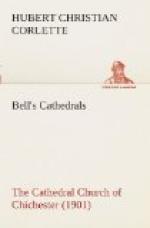“Mr. Butler informs
me that there is evidence to show that
the north tower was
taken down by the advice of Sir
Christopher Wren, on
account of its ruinous condition.”
[19] “Archaeological History,” Chichester, p. 6, note c.
But Praecentor Ede, in a paper written about 1684 A.D. and quoted by Praecentor Walcott, [20] gives
“an account of Dr. Christopher Wren’s opinion concerning the rebuilding of one of the great towers at the west end of the Cathedral Church of Chichester, one third part of which, from top to bottom, fell down above fifty years since, which he gave after he had for about two hours viewed it both without and within, and above and below, and had also observed the great want of repairs, especially in the inside of the other great west tower, and having well surveyed the whole of the west end of the said Church, which was in substance as followeth; that there could be no secure building to the remaining part of the tower now standing; that, if there could and it were so built, there would be little uniformity between that and the other, they never having been alike nor were they both built together or with the Church, and when they were standing the west end could never look very handsome. And therefore considering the vast charge of rebuilding the fallen tower and repairing the other, he thought the best way was to pull down both together, with the west arch of the nave of the church between them; and to lengthen the two northern isles to answer exactly to the two southern; and then to close all with a well designed and fair built west end and porch; which would make the west end of the church look much handsome than ever it did, and would be done with half the charge.” [21]
[20] “Early Statutes,” p.
21.
[21] Walcott, “Early Statutes”
p. 21
Such was Dr. Wren’s opinion of the west front. It is fortunate that his advice was not followed, for have we not the same west front still in existence? However, Wren spoke of “the remaining part of the tower now standing,” and King’s print, publishing 1656, shows the portion to which he referred. Fuller [22] remarked in 1662 that the church “now is torn, having lately a great part thereof fallen to the ground.” He no doubt refers to the same ruin, for it is not to be conjectured that any other part fell then.
[22] “Worthies,” II, 385
Sir Christopher Wren says the towers never were alike in design, nor were they “both built together.”
The edition of Dugdale’s “Monasticon,” published in 1673, gives a view of the north facade of the church. Ede, writing in 1684, said that “above fifty years” before one-third part of the north-west tower had fallen from top to bottom; yet this illustration shows that same tower complete. This affords an opportunity of comparing portions of the two towers. The upper part of each is shown to finish on top with a battlement parapet. It




